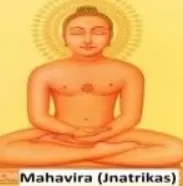Mahajanapadas-and-rise-of-magadha / Mahajanapadas and Rise of Magadha / 16 Mahajanapadas
The Mahajanapadas
During the 6th century BCE (second urbanisation era), 16 ancient kingdoms and republics called Mahajanapadas appeared in northern India. The term 'Mahajanapadas' means 'great kingdoms' or 'great states'.
- It means 'vast realm' in Sanskrit, combining 'maha' for 'great' and 'janapada' for 'foothold of a people'."

- Geographical Factor: The 16 Mahajanapadas were mostly situated in what is now Bihar and Uttar Pradesh.
- Types: They included both monarchies (Rajyas) and non-monarchical states known as Ganas or Sanghas.
- Source of Information: The Anguttara Nikaya, a Buddhist scripture from the Sutta Pitaka, sheds light on the social, political, and economic conditions of ancient India during that time.
- Other sources:
- The Mahavastu, a Buddhist work
- Bhagavati Sutra, a Jaina work, provides differing lists of the sixteen Mahajanapadas, with some including Vanga and Malaya.
- Around this era, the use of iron tools became widespread, aiding the clearing of forests in the Gangetic plains and leading to eastward civilization expansion.
- Iron tools improved agricultural practices, resulting in surplus food production used for the needs of kings for military and administrative purposes.
- An agrarian economy allowed people to settle and expand into neighbouring regions.
- Sixteen prominent Mahajanapadas emerged, including both monarchical and republican states.
- Mahajanapadas Monarchies and Republics -
- Monarchies:
- Gandhara, Kamboja, Kashi, Vatsa, Avanti, Chedi, Kuru, Panchala, Matsya, Anga, Kosala, Magadha, Surasena
- Republics:
- Asmaka, Malla, Vajji
- The monarchs had supreme authority in some Mahajanapadas, while republican states were governed by assemblies of senior citizens, known as the Gana-parishad, which made administrative decisions.
Monarchies
1. Kashi
- Kashi was among the foremost and most dominant of the sixteen Mahajanapadas.
- Around 450 BCE, it emerged as a significant town with its capital at Varanasi.
- Renowned for its cotton textiles and horse market, it played a role in the downfall of the Videhan monarchy.
- River Varuna in the north and river Assi in the south bounded ancient Kashi.
- Kashi frequently clashed with the kingdoms of Kosala, Magadha, and Anga. Despite defeating Kosala initially, it was eventually conquered by Kosala and later annexed by Ajatasatru to Magadha.
2. Kosala
- The Shatpath Brahman provides insights into the Kosala Mahajanapada, with its capital at Shravasti, located northwest of Magadha in present-day eastern Uttar Pradesh.
- Kosala was bounded by the Gomati River in the west, the Sarpika or Syandika River in the south, the Sadanira (Gandak) River in the east, and the Nepal hills in the north.
- Ayodhya, Saketa, and Shravasti were the key cities in Kosala, and its kings supported both Brahmanism and Buddhism.
- King Prasenjit of Kosala was contemporaneous with Bimbisara and Ajatasatru of Magadha. A conflict over Kashi ensued due to family disputes, resulting in several battles and reconciliations.
- Despite not embracing Buddhism, a Bharhut sculpture indicated friendly relations between Prasenjit and Buddha.
- Eventually, during Ajatasatru's rule, Magadha annexed Kosala after Prasenjit's demise. Kosala also encompassed the tribal republican territory of the Sakyas of Kapilvastu, identified with Piprahwa in Basti district, close to Lumbini in Nepal, the birthplace of Gautam Buddha.

3. Anga
- Anga was an ancient region, referenced in Brahmanical works like the Aitareya Brahmana, the Mahabharata, the Puranas, and the Ramayana.
- Located east of Magadha and west of the Raj Mahal hills, its capital was at Champa, corresponding to modern-day districts of Munger and Bhagalpur.
- It was known for its wealth and commerce, with its merchants frequently visiting Suvarnabhumi.
- During Bimbisara's rule, Anga was annexed to Magadha, marking the sole conquest by Bimbisara.
4. Magadha
- The name Magadha is first found in the Atharvaveda and is among the prominent Mahajanapadas.
- Positioned between Anga and Vatsa, it corresponds to modern Patna and Gaya districts in Bihar and eastern parts of Bengal.
- Bounded by the Ganga and Son rivers in the north and west, the Vindhyas outcrop in the south, and the Champa River in the east.
- Initially, the capital was Rajagriha or Girivraja, guarded by five hills. Later, it shifted to Pataliputra.
- Magadha gained prominence under the rule of Bimbisara and Ajatsatru, encountering conflicts with neighbouring Licchavis and Vajjis.
- Pataligama, an ancient site of Pataliputra, witnessed the construction of a fort by Ajatasattu's ministers to counter the Vajjis.
- The ancient city of Giribbaja was encircled by five hills named Isigili, Vepulla, Yebhara, Pandava, and Gijjhkuta.
5. Vatsa

- Vatsa traces its origins to the Rig Vedic period, believed to be an offshoot of the Kurus who settled in Kaushambi, corresponding to modern-day Allahabad and Mirzapur in UP.
- Kaushambi served as the prosperous capital, serving as a significant trade hub for goods and passengers from the south and the west.
- Udayana, the sixth-century BCE ruler, engaged in conflicts with Magadha's king Ajatasatru and Avanti's king Pradyota, eventually forming alliances through matrimonial ties.
- Initially opposed to Buddhism, Udayana later embraced it and made it the state religion.
- During Palaka's reign, Vatsa was incorporated into the Avanti kingdom.
6. Avanti
- The Avanti kingdom encompassed modern Malwa, with Ujjayini initially serving as the capital of northern Avanti and Mahissmati as the capital of Southern Avanti. Later, Ujjayini (modern Ujjain) became the capital of the unified Avanti.
- Avanti was divided into the north and south by the Netravati river.
- Chanda Pradyota, the ruler during Buddha's time, was known for his fierceness but later embraced Buddhism.
- Avanti emerged as a significant Buddhist centre.
- Ultimately, the Magadha Empire annexed the kingdom of Avanti under the rule of Sishunaga.
7. Gandhara
- Gandhara was situated roughly in the area of modern Kashmir, extending up to the Kabul valley.
- Taxila served as its capital and was renowned as a prominent centre of learning where scholars from all over the world gathered.
- Positioned on the Uttarapatha, it was a hub for commercial activities.
- According to Buddhist tradition, Gandhara King Pukkusati exchanged gifts with Bimbisara of Magadha and travelled to meet the Buddha on foot.
- Later, it became the twentieth province of the Achaemenid Empire (Persian) as per the Greek historian Herodotus.
8. Kamboja
- Kamboja was a country neighbouring Gandhara in the far North-West with Dwarka as its capital.
- It is often linked with Gandhara in both literature and inscriptions, mentioned in Yaska's Nirukta and Ashoka's edicts alongside Yona as frontier provinces.
- Prior to 530 BCE, it was conquered by Cyrus, the Achaemenid emperor of Persia, who reportedly destroyed the Kamboja city of Kapisi (modern Begram).
- During Kautilya's era, Kamboja transitioned from a monarchy to a republic.
- Kamboja was renowned for its horses throughout Indian history, with Sumangalavilasini depicting it as the home of horses.
9. Matsya
- Matsyas were one of the notable Ksatriya tribes within the early Vedic Aryan community in India.
- A hymn in the Rigveda recounts an attack on the Matsyas by the renowned king Turvasa.
- The Matsyas or the Matsya kingdom are mentioned in various texts such as the Satapatha Brahmana, the Kausitaki Upanisad, the Mahabharata, the Padma Purana, and the Visnudharmottara Mahapurana.
- Their capital was at Viratnagar, and their territory roughly corresponds to the former state of Jaipur in Rajasthan, including a portion of Bhagalpur.
10. Kurus
- The Kurus were a significant and ancient Indo-Aryan Ksatriya tribe.
- Their capital was at Hastinapur, and their territory roughly corresponds to modern Delhi and the adjoining doab region.
- While the Kurus were highly important during the later Vedic period, their prominence had diminished by the sixth century BCE.
11. Panchala
- The Panchala Mahajanapada was situated in the Rohilkhand and parts of the Central Doab (modern districts of Bareilly, Badaun, Aligarh, etc.).
- Panchala was divided into northern Panchala with its capital at Ahicchatra (Bareilly district) and southern Panchala with Kampilya as its capital.
- The well-known city of Kannauj was within the kingdom of Panchala.
- By the 6th century BCE, the prominence of Panchala had faded.
12. Chedi
- The kingdom of the Chedis was located approximately in the eastern areas of Bundelkhand and nearby regions.
- Sotthivati (Suktimati) served as its capital, likely situated in the Banda district of Madhya Pradesh.
- The Chedi tribe has an ancient history among the Ksatriyas during the early Vedic times.
- The Chedi country was located near the Yamuna River, adjacent to the Kurus' territory.
- It had close ties with the Matsya and Kashi kingdoms. In the Mahabharata, it is referred to as Suktimati or Suktisahvaya in Sanskrit.
13. Surasena
- The Surasenas were centered around their capital at Mathura, situated along the Yamuna River at the crossroads of important trade routes.
- Despite their strategic location, the fragmented political structure and diverse terrain hindered the formation of a strong kingdom.
- The Mahabharata and the Ramayana reference the Surasenas alongside neighbouring tribes such as Salvas and Kuru-Panchalas.
- Mathura is specifically highlighted in Buddhist texts as the capital of the Surasena kingdom, referred to as Madhura.
Republics (Gana-Sanghas)
1. Vajjis (Vrijji)

- The Vajji confederacy comprised eight clans, including the Videhas and the Lichchhavis, each with its own capital like Mithila and Vaishali.
- Located north of the Ganga, the Vajji territory extended to the Nepal hills in Bihar, with the Gandak River marking its western boundary and the Koshi and Mahananda Rivers defining its eastern limit.
- Following the decline of the Videhan monarchy, the Vajji confederation likely emerged as a republic during the time of Mahavira and Gautama Buddha.
- Ajatasatru, the king of Magadha, is believed to have brought about the destruction of this confederacy.
2. Mallas
- The Mallas' territory was split into two divisions, each governed from the cities of Kusinara (linked to Kasia in Gorakhpur) and Pava (modern Padrauna).
- These cities hold significance in both Buddhism and Jainism, with Kusinara being the place of Buddha's passing and Pawapuri being the site of Mahavira's nirvana.
3. Asmaka (Assaka)
- The kingdom of Assaka (Asmaka) was positioned close to the Godavari River, with its capital located at Patali or Potna in present-day Maharashtra.
- According to the Anguttara Nikaya, the region was known for its wealth, prosperity, and abundance of food and gems, eventually gaining commercial importance.

